
Panama City Cooking 02
January 27th, 2010
by Juan Duque
Hi! Welcome back to Panama City Cooking. This month I wanted to feature a local restaurant, so you guys could get an idea of what kinds of food we have over here. For this first one I chose the Bar and Grill El Carbón Rojo. It’s basically “The Red Charcoal” in Spanish. This used to be another restaurant decades ago, until it was bought by three Greek brothers in the early 80’s and got its current name. We actually went behind the scenes for this one!
It’s a very popular restaurant with a loyal clientele that’s been there for years. It’s a big hit with families on the weekends, since it’s not very expensive, and there’s a wide range of dishes to choose from. The food’s not very fancy or extravagant, but there’s surely something for everyone on the menu.
It’s a very laid back restaurant, with fresh air all over the place. No air conditioning here! It’s the kind of place you’d go on a nice Sunday afternoon to grab something to eat, drink and maybe watch a game, if you’re into that!


There’s plenty of parking space in the front and back, and as you can see, there’s a lot of little “ranchos” or “bohios” (open-air seating, essentially) where people can sit down and eat.

Their specialty is charcoal-grilled meats, and they’re all pretty tasty. It’s what keeps people coming back to the place (well, that and the bar, of course). They cook those in a pretty open space, as you can see in the picture above.

We ate at what they call “El Rancho Grande”, which is the biggest seating area they have there, with about a dozen tables inside.
The menu is mainly divided into meat, poultry, seafood, and pork. And there’s also the appetizers, dessert and refreshments, of course. There are lots of drinks to choose from, and plenty of different beers, from two national beers (Panama and Soberana), to imported beers which I guess are pretty common to our regular readers (Heineken, Budweiser, etc.). There’s also a Greek beer called Mithos in there. Again, the place is always pretty packed with people drinking at the bar.

You get this little salad with every dish. It’s not quality lettuce, but the tomato with a little parsley and grated carrot made it better. It’s not really that great, but it’s appreciated. They have a way better Greek salad which you can try.

There’s something you guys should know about this place: it has really kick-ass seafood. I mean, the trademark charcoal-grilled stuff is pretty great, but the seafood is surprisingly good and fresh. I ordered a shrimp ceviche as an appetizer, and it was very tasty. Ceviche is basically raw seafood marinated with lemon (or other citrus), chopped onion, garlic, and a little lettuce leaf. It’s really good! It comes with a few salt cookies here. I thought it could’ve used fewer onions, but it was still good. I’m just picky with that stuff. You can also get the octopus ceviche, corvina ceviche, clam ceviche, and even a combination of octopus, shrimp and corvina.

The lemonade was amazing. I think the lemons they use are mandarin limes, actually. I’m not sure about that, but they call them “limón mandarina” over here, so it should be true! It’s a lemon and mandarin orange hybrid. If you slice it up, it kinda looks like an orange. Honestly, regular lemons are fine, but lately I’ve been really enjoying lemonade with these. They use raspadura to sweeten it, which is raw sugar without refining. I don’t know how healthy this is, but it’s definitely tastier. It tastes a little bit like honey, but not quite. It’s a very specific flavor, which in my opinion makes the lemonade way better. And I already like regular lemonade a lot, since it’s what I’ll usually drink whenever I want to drink something that’s not just water.
I went with my brother and my girlfriend, so you’ll see three different dishes you can have at El Carbón Rojo. I should point out that every dish comes with yucca, patacones, or french fries. Sadly, they didn’t have yucca this time. What we call yucca is actually the yucca root. You can cook it like a potato, which is why it’s usually served as something similar to french fries, only that it’s yucca! It’s supposed to be healthy, and a good carb to go with any type of food. Of course, it’s fried yucca here, so it’s not really that healthy. I have to stop saying yucca.

I had half a charcoal-grilled chicken (can you get the entire chicken? I don’t know!). It’s really one of the best things you can order here. Really, don’t go for the fried chicken, this one’s worth trying. I know some people don’t find eating chicken very exciting, but the charcoal grill definitely makes a difference here. There’s a little bit of chimichurri on top, but it’s pretty basic. Just the red pepper flakes, olive oil, minced garlic and chopped celery. It’s very mild, so it didn’t really overpower the chicken’s flavor, just enhanced it. The french fries were okay, but they’re really made from the potatoes they have there, so they get a little soggy if you don’t eat them quickly enough.

My girlfriend had grilled corvina (I think it’s also known as white sea bass), with a special Greek salad side. The corvina was really fresh, according to her, and it didn’t have that fishy odor you can sometimes encounter. It was light, but consistent and crispy on the edges. She asked for one of the mandarin limes, and squeezed a little of its juice on the corvina, which apparently made it even better. The Greek salad is not really on the menu as something you can just order with your dish, but it was a special request. And by the way, I’ve tried the Greek salad before, and it’s AMAZING. Again, the owners are Greek, so they know their stuff. You can see they really give you plenty of big, chunky feta cheese, with a little bit of parsley on top. The rest is tomatoes, cucumber, authentic Greek kalamata olives, lettuce, and of course, the extra virgin olive oil. Actually, she ordered it without the olive oil, but it’s much better with it. It usually comes with onions too, but I definitely think it’s better without them. The owners actually order huge boxes of olive oil from Greece, which makes it extra special.

My brother had breaded king prawns. Like I said, the seafood here is very good, and this is what I usually order when I go to El Carbón Rojo, since they’re actually pretty big and always feel fresh. In fact, they get them from the seafood market pretty early in the morning. If you don’t like breaded seafood, which is completely understandable, you can have them grilled, which I know many people would prefer. There’s also the garlic king prawns, but I can’t comment on their quality, because I’ve never tried them here. I’ve had these in other restaurants, and they’re sometimes dry or simple, but these are almost always great. I like dipping them in the tartar sauce they give you, or just squeezing a little mandarin lime juice on them, which can be pretty delicious too.

For dessert I had homemade flan. It was okay, but I’m not a big fan of cheesecake, and this definitely had a similar texture, so it wasn’t for me. Cheesecake lovers will definitely like it, though! I did think it was a little small for the price ($3.25), so unless you really like this type of flan, I don’t think I’d recommend it.

On the other hand, there’s the peach charlot. My brother had this peach charlot. Really, this is the one to get. It was incredibly good. I’m gonna have to back and get this again, since I only had a bite of his. As I understand, it's made with vanilla custard, crumbled lady fingers, canned peaches, and some sort of light syrup that we couldn't really figure out. It also has Chantilly cream with chopped nuts on top. Oh, there’s also kourabiedes, which is a Greek dessert.
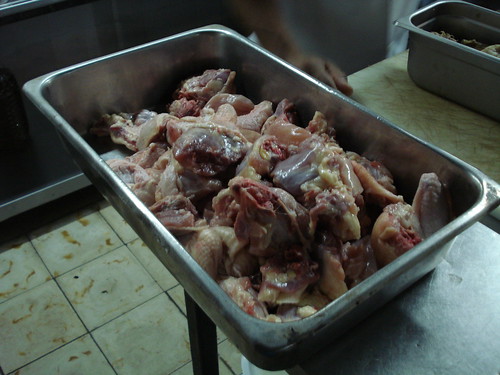
The nice people at El Carbón Rojo granted us access to their kitchen, so we could take a few pictures of their sancocho process. Sancocho is a traditional Latin American soup, made with chicken, garlic, yams (called ñame here), otoe (similar to taro), onions, celery, and cilantro. Some people also use red peppers and oregano.
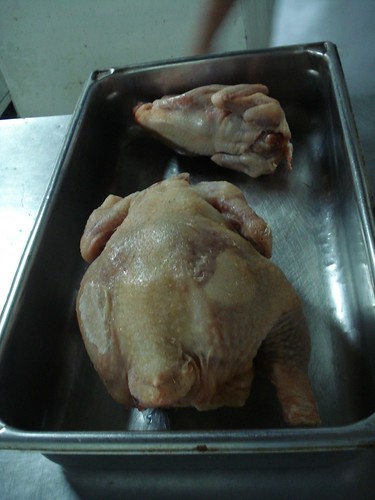
The chef started by explaining how he prefers using what we call “gallina dura.” This is basically a mature hen, with harder meat. Some people don’t really like how gallina dura tastes, but he explained it’s an important part of their sancocho, because of how much flavor a big hen gives the soup. You can see one in the picture, next to a tiny chicken, which can also be used for sancocho. The difference is that when using a tiny chicken, you’d have to use chicken stock to get the real sancocho flavor. So that’s why they prefer to use gallina dura.
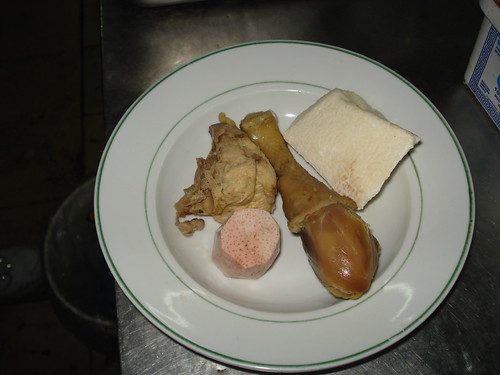
This is an example of how a sancocho is presented when it’s finally served (sans the actual soup, of course!). Otoe is the little pinkish cube you see there. It’s a root vegetable that’s found here in Panama, with a very mushy texture. It’s kind of like a mushy potato.
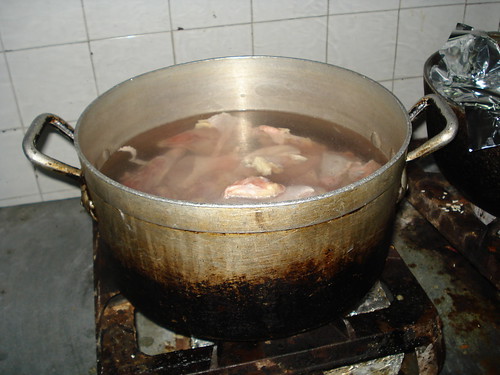
Making a sancocho is very simple. We weren’t allowed to stay there a long time, so I’ll show you what we captured.
He first cut up the big hen into pieces, which will be used when serving it to clients, and cleaned them. He took a decent sized pot and filled about ¾ of it with water, then he put the pieces of chicken in the pot, with high heat.
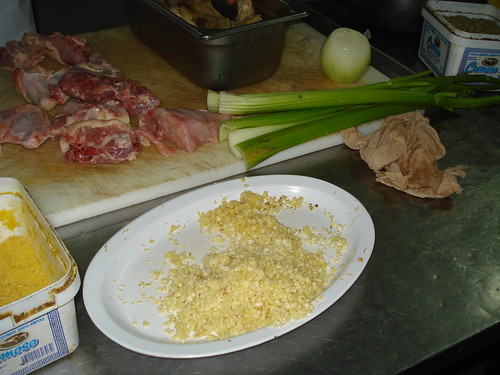
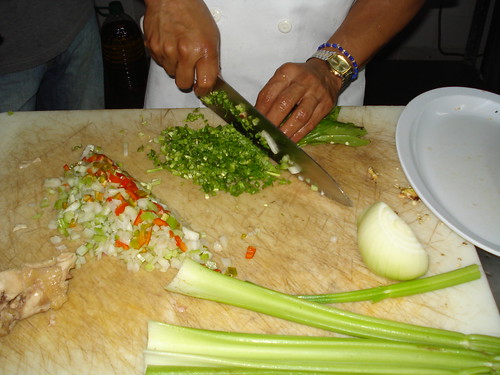
Meanwhile, he chopped the garlic, onions, celery, and red peppers, and cilantro into fine pieces.

Every now and then he’d scoop a little bit of fat and stuff that came off the hen, off the top. He told us how he usually takes about half the fat that comes out from the hen, or else you’d be eating a soup that feels very heavy. And trust me, I’ve had those types of sancochos, and they’re never good.
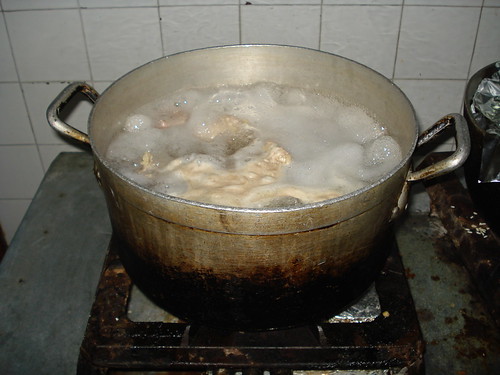
After a while he added the chopped garlic to the pot, and a little bit of salt.
We weren’t allowed to stay much after this, because the process takes about two hours, but he explained to us what he was gong to do next. You have to leave the pieces of hen boiling with the salt and garlic, and add about half of the onions, celery and red peppers after quite a while. Then a little bit after that, you’ll add the otoe, and the ñame, but not all of it. The reason for this is that it’d make the sancocho feel too thick, and also because it tends to dissolve, and people like to see their big piece of ñame when they’re eating their sancocho.
When the hen pieces are tender, you’ll have to remove them. At this point, you’ll add the rest of the onions, peppers and celery to the pot, and also the rest of the ñame, and reduce the heat a little. After some time, you’ll finally add the cilantro and oregano, and reduce the heat to low. You have to keep it going for a few more minutes, and you can also add salt at this point if you feel it’s necessary. Then you’ll be done with your sancocho, and all that’s left is serving the soup in a plate, and adding the hen pieces.
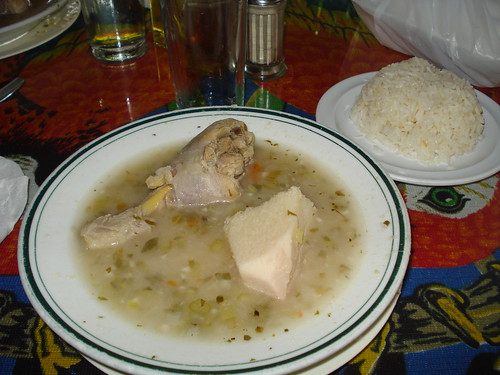
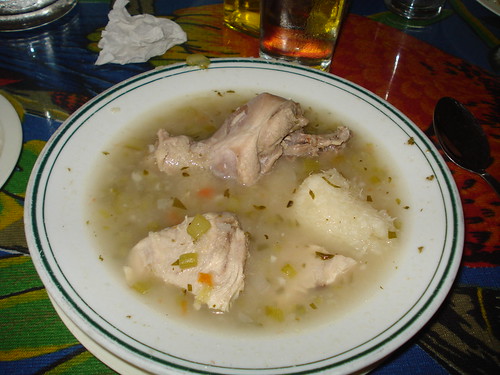
We actually went back a few hours later to try the sancocho, and I’m happy to say it was delicious. The only thing missing was a little bit of mandarin lime juice, which for some reason we didn’t get when we asked for it. But the sancocho itself was great, it felt very light but full of flavor. And even though you’d expect the hen pieces to be hard or chewy, they weren’t at all! They were very soft, with a great taste. My girlfriend said her ñame could’ve used a little more time in the pot, but otherwise it was delicious.

I hope you enjoyed this installment of Panama City Cooking. See you again next month!

No comments:
Post a Comment